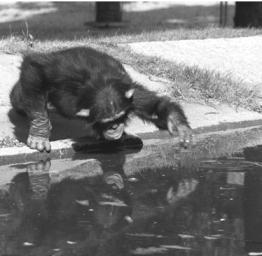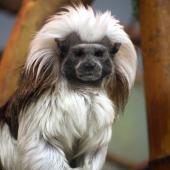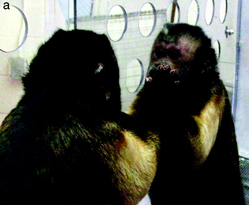I used to have a mirror on the back of my bedroom door until some rather aggressive knocking caused it to fall off. Unfortunately there are many other mirrors around the house so I still don’t have an excuse for not ensuring my hair is neat and tidy at all times (a point my girlfriend is fond of reminding me of). The fact humans can recognise ourselves in the mirror (and thus receive these criticisms) is not something we often give a second thought to, yet it is actually quite a significant ability.
Granted it’s not like we evolved to recognise ourselves in the mirror, nor is it a particularly useful ability (aside from trying to avoid criticism from loved ones) but it’s still important because it shows I am self-aware. The fact I can recognise myself means that I’m aware of the fact that I’m a distinct, physical object in the world. This knowledge forms the foundation of many more complex thought-processes, such as the theory of mind (de Waal et al., 2005).

A classic test of theory of mind for children. They can correctly solve it around age 6.
Theory of mind (ToM) is our ability to understand that other individuals have their own minds, with different thoughts, feelings, desires, emotions, motivations and goals. It’s a crucial ability for creating and maintaining a complex society and as far as we know humans are the only species that can do it. This important, complex and uniquely human ability is based on being able to recognise that I am separate from you; that I am a distinct, physical entity that can be recognised in the mirror.
Being able to recognise yourself in the mirror shows we are self-aware, which is the first step towards many complex cognitive abilities. So when we want to figure out the cognitive capabilities of other animals checking to see whether or not they can recognise themselves in the mirror is a good place to start. For years researchers have been drawing dots on the forehead of animals and placing them in front of mirrors. If the animal rubs their own forehead it shows they know that they’re seeing themselves in the mirror.
Over the years animals have spent thousands of hours staring at mirrors, during which time we’ve recognised a pattern: apes can recognise themselves in the mirror but monkeys cannot (Hauser et al., 1995). Ostensibly this makes sense, since apes have bigger brains than monkeys and display a wider range of more complex behaviour. There’s even some suggestion that chimpanzees have a sort of theory of mind (Crockford et al., 2011).

A chimp playing with its reflection in the water
However, Hauser et al. (1995) noted that the classic “dot” test may be unfair on monkeys. Traditionally a dot of paint would be drawn on the forehead and the animal would be placed in front of a mirror to see if they recognise that they’ve been drawn on. Sometimes the researchers go a bit further and even colour their eyebrows a strange colour IN THE NAME OF SCIENCE. Within 3 minutes chimps realise that they’ve been drawn on and touching their head, rather than the spot on the mirror (Povinelli et al., 1997).
Yet monkeys often few direct eye-contact as a form of aggression, so immediately look away from the mirror. They never get the chance to look at it long enough to realise that they’re the ones in the mirror. So Hauser and his team decided to alter the monkey’s appearance so radically that it would overpower their fear of eye contact. They’d look so crazy they just had to stop and stare for a while, hopefully giving them enough time to realise it’s them in the mirror.

A regular cotton top tamarin (or maybe one whose hair was dyed white)
Personally I’d have loved to be in the boardroom meeting where they decided just how crazy they had to make the monkey. “Colour them completely pink”, “give them a funny hat with a propeller on” and “draw on glasses with permanent marker” were likely suggestions considered. The monkeys they were experimenting on were cotton-topped tamarins who, as the name suggests, have a big white Mohawk. The researches decided to dye their hair a range of florescent colours, including green (and in a crime against humanity, they did not take any pictures of these punky tamarins). They also dyed some of them white to ensure it was not the smell or other factor that influenced their behaviour.
Contrary to all previous studies of monkeys and mirrors they found that their crazy-colour tamarins recognised themselves in the mirror. They touched their own hair, didn’t behave aggressively towards the mirror and stared at it for a long time; all signs they realised it was them in the mirror and are self-aware after all.
A similar study was performed on capuchins (de Wall, 2005). Two cages were placed next to each other with a capuchin in each one. These cages were sometimes separated by a mirror, sometimes by plexiglass (so the capuchins could see each other). They behaved very differently when they saw their reflection than when they saw a stranger, showing they can distinguish between the two. The females responded particularly strangely to their reflect, leading to one of my favourite lines in a scientific paper ever
Females treat their reflection positively, engaging in lots of eye contact, friendly swaying, and lip smacking. They almost “flirt” with their reflection.
Unfortunately, this odd doesn’t mean they recognise their reflection (as the researchers themselves are quick to point out). However, given they didn’t paint the capuchins or do anything else they could respond to with self-recognition this study isn’t really a test of whether they are self-aware, one way or another. I’m only really bringing it up because I like flirty capuchins.

A capuchin playing with its reflection. It may or may not be flirting.
In short then it would seem that monkeys are self-aware animals capable of recognising themselves in the mirror, like apes and humans. This reduces the intellectual gulf between apes and the rest of the primates, showing that our intelligence isn’t that unique. Clearly humans aren’t quite as cognitively “advanced” as we might like to think.
References
Crockford C, Wittig RM, Mundry R, & Zuberbühler K (2011). Wild Chimpanzees Inform Ignorant Group Members of Danger. Current biology : CB PMID:
de Waal, F. B., Dindo, M., Freeman, C. A., & Hall, M. J. (2005). The monkey in the mirror: hardly a stranger. Proceedings of the National Academy of Sciences of the United States of America, 102(32), 11140-11147.
Hauser, M. D., Kralik, J., Botto-Mahan, C., Garrett, M., & Oser, J. (1995). Self-recognition in primates: phylogeny and the salience of species-typical features.Proceedings of the National Academy of Sciences, 92(23), 10811-10814.
Povinelli, D. J., GALLUP, J., GORDON, G., EDDY, T. J., BIERSCHWALE, D. T., ENGSTROM, M. C., … & TOXOPEUS, I. B. (1997). Chimpanzees recognize themselves in mirrors. Animal Behaviour, 53(5), 1083-1088.

